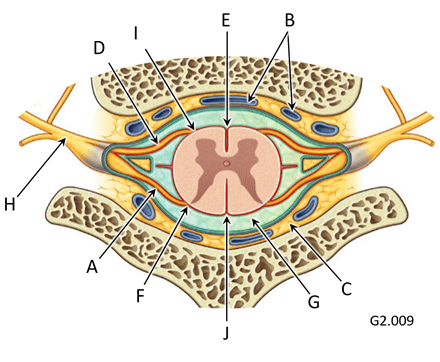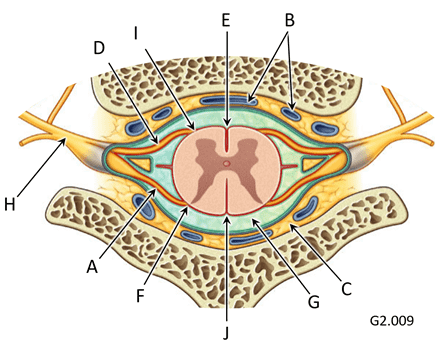Question 1
1) Identify A.
Choices:
- a sensory nerve
- internal vertebral venous plexus
- extradural (epidural) space
- a purely motor nerve
- ventral median fissure
- dorsolateral sulcus
- subarachnoid space
- a mixed nerve
- ventrolateral sulcus
- dorsolateral sulcus
Answers:
- a sensory nerve
Comments:
- Correct
- That's right! The dorsal root (A) conducts sensory information from both the body wall and its contained viscera into the dorsal horn of spinal cord.
- Continue
Question 2
2) Identify B.
Choices:
- a sensory nerve
- internal vertebral venous plexus
- extradural (epidural) space
- a purely motor nerve
- ventral median fissure
- dorsolateral sulcus
- subarachnoid space
- a mixed nerve
- ventrolateral sulcus
- dorsolateral sulcus
Answers:
- internal vertebral venous plexus
Comments:
- Correct
- That's right! A padding layer of adipose and the internal vertebral venous plexus (B) are contained within the extradural (epidural space) – space between the bony vertebral canal and the spinal dura.
- Continue
Question 3
3) Identify C.
Choices:
- a sensory nerve
- internal vertebral venous plexus
- extradural (epidural) space
- a purely motor nerve
- ventral median fissure
- dorsolateral sulcus
- subarachnoid space
- a mixed nerve
- ventrolateral sulcus
- dorsolateral sulcus
Answers:
- extradural (epidural) space
Comments:
- Correct
- That's right! The extradural (epidural) space is the space between the bony vertebral canal and the dura mater. You can find adipose padding and the internal vertebral venous plexus here.
- Continue
Question 4
4) Identify D.
Choices:
- a sensory nerve
- internal vertebral venous plexus
- extradural (epidural) space
- a purely motor nerve
- ventral median fissure
- dorsolateral sulcus
- subarachnoid space
- a mixed nerve
- ventrolateral sulcus
- dorsolateral sulcus
Answers:
- a purely motor nerve
Comments:
- Correct
- That's right! The ventral root (D) contains fibres that carry motor commands from the spinal cord to somatic and (sometimes) visceral targets.
- Continue
Question 5
5) Identify E.
Choices:
- a sensory nerve
- internal vertebral venous plexus
- extradural (epidural) space
- a purely motor nerve
- ventral median fissure
- dorsolateral sulcus
- subarachnoid space
- a mixed nerve
- ventrolateral sulcus
- dorsolateral sulcus
Answers:
- ventral median fissure
Comments:
- Correct
- That's right! The ventral median fissure (E), together with the dorsal median sulcus, separate the spinal cord into right and left sides.
- Continue
Question 6
6) Identify F.
Choices:
- a sensory nerve
- internal vertebral venous plexus
- extradural (epidural) space
- a purely motor nerve
- ventral median fissure
- dorsolateral sulcus
- subarachnoid space
- a mixed nerve
- ventrolateral sulcus
- dorsolateral sulcus
Answers:
- dorsolateral sulcus
Comments:
- Correct
- That's right! The dorsolateral sulcus (F) and the ventrolateral sulcus subdivide the spinal cord white matter into the ventral, lateral and dorsal columns.
- Continue
Question 7
7) Identify G.
Choices:
- a sensory nerve
- internal vertebral venous plexus
- extradural (epidural) space
- a purely motor nerve
- ventral median fissure
- dorsolateral sulcus
- subarachnoid space
- a mixed nerve
- ventrolateral sulcus
- dorsolateral sulcus
Answers:
- subarachnoid space
Comments:
- Correct
- That's right! CSF fills the subarachnoid space (G). The hydrostatic pressure of CSF holds the arachnoid mater against the dura mater and separates it from the pia mater.
- Continue
Question 8
8) Identify H.
Choices:
- a sensory nerve
- internal vertebral venous plexus
- extradural (epidural) space
- a purely motor nerve
- ventral median fissure
- dorsolateral sulcus
- subarachnoid space
- a mixed nerve
- ventrolateral sulcus
- dorsolateral sulcus
Answers:
- a mixed nerve
Comments:
- Correct
- That's right! A spinal nerve (H) is a mixed nerve which contains both sensory and motor fibres.
- Continue
Question 9
9) Identify I.
Choices:
- a sensory nerve
- internal vertebral venous plexus
- extradural (epidural) space
- a purely motor nerve
- ventral median fissure
- dorsolateral sulcus
- subarachnoid space
- a mixed nerve
- ventrolateral sulcus
- dorsolateral sulcus
Answers:
- ventrolateral sulcus
Comments:
- Correct
- That's right! The ventrolateral sulcus (I) subdivides the white matter of the spinal cord into ventral and lateral columns.
- Continue
Question 10
10) Identify J.
Choices:
- a sensory nerve
- internal vertebral venous plexus
- extradural (epidural) space
- a purely motor nerve
- ventral median fissure
- dorsolateral sulcus
- subarachnoid space
- a mixed nerve
- ventrolateral sulcus
- dorsal median sulcus
Answers:
- dorsal median sulcus
Comments:
- Correct
- That's right! The dorsal median sulcus (J) runs the length of the spinal cord, dividing its dorsal white matter into right and left portions.
- Continue
Question 11
11) Which intervertebral disc has herniated?
Choices:
- L2-L3
- L3-L4
- L4-L5
- L5-S1
- S1-S2
Answers:
- L4-L5
Comments:
- Correct
- That's right! Start by identifying the sacral promontory, which marks the S1 vertebral body. Then count up to localize the herniated disc between the L4 and L4 vertebrae.
- Continue
Question 12
12) Identify A.
Choices:
- ventral median fissure
- dorsal median sulcus
- somatic motor cell bodies
- dorsal column
- visceral motor cell bodies
- lateral column
- sensory cell bodies
- sensory axons enter
- ventral column
Answers:
- ventral median fissure
Comments:
- Correct
- That's right! The ventral median fissure is wider than the dorsal median sulcus.
- Continue
Question 13
13) Identify B. Quiz
Choices:
- ventral median fissure
- dorsal median sulcus
- somatic motor cell bodies
- dorsal column
- visceral motor cell bodies
- lateral column
- sensory cell bodies
- sensory axons enter
- ventral column
Answers:
- dorsal median sulcus
Comments:
- Correct
- That's right! The dorsal median sulcus is labelled ‘B’. Remember, a fissure is deeper and wider than a sulcus!
- Continue
Question 14
14) Identify C. Quiz
Choices:
- ventral median fissure
- dorsal median sulcus
- somatic motor cell bodies
- dorsal column
- visceral motor cell bodies
- lateral column
- sensory cell bodies
- sensory axons enter
- ventral column
Answers:
- somatic motor cell bodies
Comments:
- Correct
- That's right! Somatic motor cell bodies can be found within the ventral horn (C).
- Continue
Question 15
15) Identify D.
Choices:
- ventral median fissure
- dorsal median sulcus
- somatic motor cell bodies
- dorsal column
- visceral motor cell bodies
- lateral column
- sensory cell bodies
- sensory axons enter
- ventral column
Answers:
- dorsal column
Comments:
- Correct
- That's right! The dorsal column of white matter flanks the dorsal median fissure.
- Continue
Question 16
16) Identify E.
Choices:
- ventral median fissure
- dorsal median sulcus
- somatic motor cell bodies
- dorsal column
- visceral motor cell bodies
- lateral column
- sensory cell bodies
- sensory axons enter
- ventral column
Answers:
- visceral motor cell bodies
Comments:
- Correct
- That's right! The visceral motor cell bodies (E) are located in the intermediate position between the dorsal and ventral horns. These are sympathetic between T1 and L2 and parasympathetic between S2 and S4.
- Continue
Question 17
17) Identify F.
Choices:
- ventral median fissure
- dorsal median sulcus
- somatic motor cell bodies
- dorsal column
- visceral motor cell bodies
- lateral column
- sensory cell bodies
- sensory axons enter
- ventral column
Answers:
- lateral column
Comments:
- Correct
- That's right! The lateral column (F) of spinal cord white matter is defined by the dorsolateral and ventrolateral sulci.
- Continue
Question 18
18) Identify G.
Choices:
- ventral median fissure
- dorsal median sulcus
- somatic motor cell bodies
- dorsal column
- visceral motor cell bodies
- lateral column
- sensory cell bodies
- sensory axons enter
- ventral column
Answers:
- sensory cell bodies
Comments:
- Correct
- That's right! The dorsal horn (G) contains sensory cell bodies, including those that code for pain and temperature.
- Continue
Question 19
19) Identify H.
Choices:
- ventral median fissure
- dorsal median sulcus
- somatic motor cell bodies
- dorsal column
- visceral motor cell bodies
- lateral column
- sensory cell bodies
- sensory axons enter
- ventral column
Answers:
- sensory axons enter
Comments:
- Correct
- That's right! Sensory axons enter the dorsal horn at the dorsolateral sulcus (H).
- Continue
Question 20
20) Identify I.
Choices:
- ventral median fissure
- dorsal median sulcus
- somatic motor cell bodies
- dorsal column
- visceral motor cell bodies
- lateral column
- sensory cell bodies
- sensory axons enter
- ventral column
Answers:
- ventral column
Comments:
- That's right! The ventral column of white matter flanks the ventral median fissure.
- Continue
- Correct


























